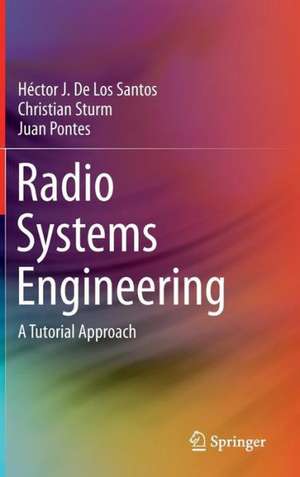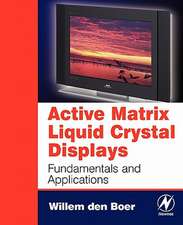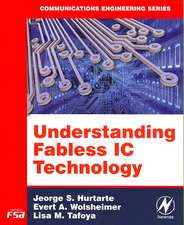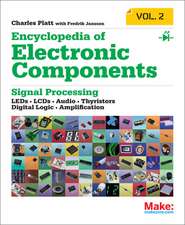Radio Systems Engineering: A Tutorial Approach
Autor Héctor J. De Los Santos, Christian Sturm, Juan Pontesen Limba Engleză Hardback – 2 sep 2014
| Toate formatele și edițiile | Preț | Express |
|---|---|---|
| Paperback (1) | 695.70 lei 43-57 zile | |
| Springer International Publishing – 10 sep 2016 | 695.70 lei 43-57 zile | |
| Hardback (1) | 639.88 lei 43-57 zile | |
| Springer International Publishing – 2 sep 2014 | 639.88 lei 43-57 zile |
Preț: 639.88 lei
Preț vechi: 752.80 lei
-15% Nou
Puncte Express: 960
Preț estimativ în valută:
122.44€ • 128.18$ • 101.31£
122.44€ • 128.18$ • 101.31£
Carte tipărită la comandă
Livrare economică 07-21 aprilie
Preluare comenzi: 021 569.72.76
Specificații
ISBN-13: 9783319073255
ISBN-10: 3319073257
Pagini: 269
Ilustrații: XVI, 253 p. 218 illus., 28 illus. in color.
Dimensiuni: 155 x 235 x 20 mm
Greutate: 0.56 kg
Ediția:2015
Editura: Springer International Publishing
Colecția Springer
Locul publicării:Cham, Switzerland
ISBN-10: 3319073257
Pagini: 269
Ilustrații: XVI, 253 p. 218 illus., 28 illus. in color.
Dimensiuni: 155 x 235 x 20 mm
Greutate: 0.56 kg
Ediția:2015
Editura: Springer International Publishing
Colecția Springer
Locul publicării:Cham, Switzerland
Public țintă
Professional/practitionerCuprins
The Logical Effort Method.- Design in the Energy-Delay Space.- Flip-Flop Optimized Design.- Analysis and Comparison in the Energy-Delay-Area Domain.- Energy Efficiency Versus Clock Slope.- Hold Time Issues and Impact of variations on Flip-Flop Topologies.- Ultra-Fast and Energy-Efficient Pulsed Latch Topologies.
Notă biografică
Héctor J. De Los Santos received the Ph.D. degree in electrical engineering from Purdue University, West Lafayette, IN, in 1989. He is currently President & CTO of NanoMEMS Research, LLC, a company he founded in 2002. From 2000 to 2002 he was Principal Scientist at Coventor, Inc., Irvine, CA. From 1989 to 2000, he was with Hughes Space and Communications Company, Los Angeles, CA, where he served as Principal Investigator and the Director of the Future Enabling Technologies IR&D Program. He is author of four books and holds over 30 U.S., European, German and Japanese patents. His research interests include, theory, modeling, simulation, and design of emerging devices (electronic, plasmonic, nanophotonic, nanoelectromechanical, etc.), and wireless communications. During the 2010–2011 academic year, he held a German Research Foundation (DFG) Mercator Visiting Professorship at the Institute for High-Frequency Engineering and Electronics, Karlsruhe Institute of Technology, Germany. He is an IEEE Fellow.
Christian Sturm received the Dipl.-Ing. (Masters) degree and the Dr.-Ing. (Ph.D.) degree in Electrical Engineering and Information Technologies from the Karlsruhe Institute of Technology, Germany, in 2005 and 2011, respectively. From 2005 to 2011 he was with the “Institut für Hochfrequenztechnik und Elektronik” (Institute for High-Frequency Engineering and Electronics) at the Karlsruhe Institute of Technology as a Research Associate. During that time he performed research on ultra-wideband systems and OFDM-based system concepts for joint radar and communications operation. Since 2011 he holds the position of System Engineer and Technical Expert at the Radar Systems Division of Valeo (formerly Valeo Raytheon Systems) in Bietigheim-Bissingen, Germany.
Juan Pontes received his Dipl.-Ing. (Masters) degree in Electrical Engineering and Information Technologies from the Universität Karlsruhe (TH), Germany, and his Dr.-Ing. (PhD) with thegrade summa cum laude from the Karlsruhe Institute of Technology, Germany, in 2005 and 2010, respectively. From 2005 to 2010 he was a Research Associate at the “Institut für Hochfrequenztechnik und Elektronik” (Institute for High-Frequency Engineering and Electronics) at the Karlsruhe Institute of Technology, Germany. Since 2011 he has worked at Robert Bosch GmbH in Leonberg, Germany, and is responsible for the antenna system design of automotive radars. His research topics include multiple-element antenna systems, wireless communication system design, wave propagation, microwave techniques, and millimeter wave antenna design.
Christian Sturm received the Dipl.-Ing. (Masters) degree and the Dr.-Ing. (Ph.D.) degree in Electrical Engineering and Information Technologies from the Karlsruhe Institute of Technology, Germany, in 2005 and 2011, respectively. From 2005 to 2011 he was with the “Institut für Hochfrequenztechnik und Elektronik” (Institute for High-Frequency Engineering and Electronics) at the Karlsruhe Institute of Technology as a Research Associate. During that time he performed research on ultra-wideband systems and OFDM-based system concepts for joint radar and communications operation. Since 2011 he holds the position of System Engineer and Technical Expert at the Radar Systems Division of Valeo (formerly Valeo Raytheon Systems) in Bietigheim-Bissingen, Germany.
Juan Pontes received his Dipl.-Ing. (Masters) degree in Electrical Engineering and Information Technologies from the Universität Karlsruhe (TH), Germany, and his Dr.-Ing. (PhD) with thegrade summa cum laude from the Karlsruhe Institute of Technology, Germany, in 2005 and 2010, respectively. From 2005 to 2010 he was a Research Associate at the “Institut für Hochfrequenztechnik und Elektronik” (Institute for High-Frequency Engineering and Electronics) at the Karlsruhe Institute of Technology, Germany. Since 2011 he has worked at Robert Bosch GmbH in Leonberg, Germany, and is responsible for the antenna system design of automotive radars. His research topics include multiple-element antenna systems, wireless communication system design, wave propagation, microwave techniques, and millimeter wave antenna design.
Textul de pe ultima copertă
This book is intended for readers who already have knowledge of devices and circuits for radio-frequency (RF) and microwave communication and are ready to study the systems engineering-level aspects of modern radio communications systems. The authors provide a general overview of radio systems with their components, focusing on the analog parts of the system and their non-idealities. Based on the physical functionality of the various building blocks of a modern radio system, block parameters are derived, which allows the examination of their influence on the overall system performance. The discussion is complemented by tutorial exercises based on the Agilent SystemVue electronic system-level (ESL) design software. With these tutorials, readers gain practical experience with realistic design examples of radio transmission systems for communications and radar sensing. The tutorials cover state-of-the-art system standards and applications and consider the characteristics of typical radio-frequency hardware components. For all tutorials, a comprehensive description of the tasks, including some hints to the solutions, is provided. The readers are then able to perform these tasks independently. A complete set of simulation models and solutions to the tutorial exercises is given.
- Offers readers a deeper understanding of the theory discussed through numerous, practical examples;
- Provides detailed coverage of the performance of real radio frequency hardware components and the persisting limits in system design;
- Integrates use of a state-of-the-art software tool for electronic system-level design.
Caracteristici
Offers readers a deeper understanding of the theory discussed through numerous, practical examples Provides detailed coverage of the performance of real radio frequency hardware components and the persisting limits in system design Integrates use of a state-of-the-art software tool for electronic system-level design Includes supplementary material: sn.pub/extras














